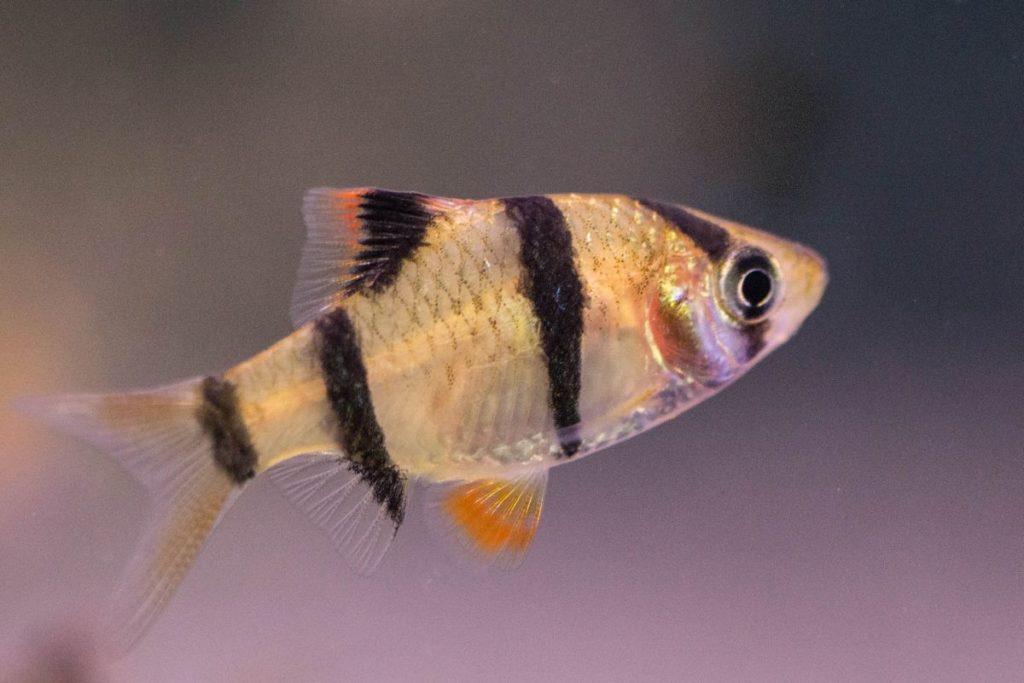The Sumatran mullet im Characteristics for Husbandry, care, characteristics and appearance and also to sigh. Above all, we also go to the distinction five-belted barbel more precisely one. There are always various discussions here. But before we come to the distinction let's look at the origin of the Sumatran mullet more closely. Like the five-girdle barb, the Sumatran barb also belongs to the carp family (Cyprinidea). We have already presented it here harlequin rasbora.
Perhaps something about the naming, because not only the name Sumatran barb or the Latin name Puntigrus tetrazona comes into play here, but very often one also reads the name of the four-girt barb, which already expresses an important characteristic of the five-girt barb.

Origin of the Sumatran barb
The fact that the Sumatran barb does not occur at all on the Sumatra island is quite funny when it comes to the origin. At least you can read about it in various works. The Sumatran barb has its origins in the Singapore and Malaysia areas. There they live mainly in calm to stagnant waters. Today, Sumatran barb are bred accordingly in all areas of the world, so that wild catches are almost non-existent. In Europe, probably the largest breeding farms can be found in the Czech Republic.
Of course, one can now ask the question why the animals are then called Sumatran barbs. This is because species have been found in Sumatra and confused with the original Sumatran barb. This could also be the five girdle barbel, although there are no exact reports.
features and appearance
The scientific description of the species also poses many question marks. It is usually confused with other species, but when it comes to identifying the animals, you should be able to rely on the four black or dark, rather wide stripes on the body. These are a distinctive identification mark and also allow them to be distinguished in comparison to the five-girdle barbs. In addition, the body shape is somewhat stockier and more compact. The animals grow up to 7 cm in size and are therefore a bit larger than the five-girdle barbel. The body is rather yellowish and one can admire the rather red fins (dorsal fins and caudal fins) as an essential feature. That is why this fish seems to be kept very often and with pleasure in our aquariums.
The distinction between males and females is rather difficult here. Basically, the female is also larger and higher-backed here. It also appears fuller, especially during spawning. The males are more intensely colored.
Sumatran barbs can live up to 7 years and are therefore one of the more robust and long-lived species in the aquarium.
Behavior of the Sumatran barb
There is also a lot to consider when it comes to behavior, because the animals are repeatedly classified as rather aggressive. In our experience, however, this is not the case. Usually their playful and lively behavior is only interpreted as such. However, you should be careful with ornamental fish that have long fins and threads. An example would be this Scalar or the gourami and Guppies to name, because there the Sumatran barb could tend to pluck their fins. Otherwise, it is important to note that the Sumatran barb should only be kept in a group. Groups of 10 or more animals are ideal. Then the ornamental fish feel particularly comfortable.
When socializing, the above points should be considered. Above all, it should be possible to socialize with other barbs or rasbora without any problems.
Water conditions and husbandry of the Sumatran barb
Let's come to the requirements in the aquarium. A group of 10 or more animals should not be kept under a tank with a capacity of 100 liters. Even larger groups of 200 liters or more are better here. In addition, the aquarium should have good hiding places in the rear area and there should also be a large amount of free space for the fish, as they are very good swimmers. That's why you read again and again that the animals have a rather hectic behavior.
There are no special requirements for the temperature. Only very warm water over 27 degrees is not made. The animals should not be kept below 22 degrees either. Compared to the five-girdle barb, Sumatran barb can be kept in a wide pH range between 6 and 7,5. There are also few requirements for the hardness of the water. Degrees of hardness up to 20 are possible here.
Basically everything is eaten here. Be it flake food or live food. Don't forget a balanced diet, including green fodder.
Breeding of Sumatran barb
Breeding is of course also possible here and in comparison to the five-girdle barb this is less demanding. However, one thing should definitely be considered. The parents also eat their eggs here and should therefore be removed from the breeding tank after spawning. Sumatran barb are spawn predators. You can try breeding in a tank with slender plants, but we recommend using a separate tank with little content. There should be a grid underneath so that the parents cannot get to the spawn. Cold water can be used to encourage the fish to spawn. The young hatch after just two days and can be reared with normal rearing food.
You should make sure that you choose an appropriate pair, because the animals are only sexually mature after about 5 months.








